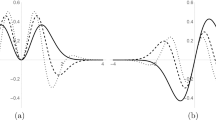Abstract
Hamilton’s equations with noise and friction possess a hidden supersymmetry, valid for time-independent as well as periodically time-dependent systems. It is used to derive topological properties of critical points and periodic trajectories in an elementary way. From a more practical point of view, the formalism provides new tools to study the reaction paths in systems with separated time scales. A ‘reduced current’ which contains the relevant part of the phase space probability current is introduced, together with strategies for its computation.
Similar content being viewed by others
References
J. Milnor, Morse Theory (Princeton University Press, 1963).
E. Witten, J. Diff. Geom. 17:661 (1982).
H. Nicolai, Nucl. Phys. B 176:419 (1980a).
H. Nicolai, Phys. Lett. B 89:341 (1980b).
G. Parisi and N. Sourlas, Nucl. Phys. B206:321 (1982).
S. Cecotti and L. Girardello, Ann. Phys. (N.Y.) 145:81 (1983).
S. Tănase-Nicola and J. Kurchan, Journal of Statistical Physics 116(5/6): (2004).
S. Tănase-Nicola and J. Kurchan, Phys. Rev. Lett. 91:188302 (2003).
E. Gozzi, Progress of Theoretical Physics Supplement 111:115 (1993).
E. Deotto, E. Gozzi and D. Mauro, J. Math. Phys. 44:5902 (2003a).
E. Deotto, E. Gozzi and D. Mauro, J. Math. Phys. 44:5937 (2003b).
A. J. Niemi, Phys. Lett. B 355:501 (1995).
A. J. Niemi and P. Pasanen, Phys. Lett. B 386:123 (1996).
M. Miettinen and A. J. Niemi, Phys. Lett. B 461:89 (1999).
H. Risken, The Fokker-Plank equation (Springer, 1996).
M. Nakahara, Geometry, Topology and Physics (Adam Hilber, 1990).
P. Jung and P. Hänggi, Phys. Rev. A. 44:8032 (1991).
J. Zinn-Justin, Quantum Field Theory and Critical Phenomena (Oxford Science Publication, 1996).
O. Cepas and J. Kurchan, cond-mat/9706296 (1997).
H. Kleinert and S. V. Shabanov, Physics Letters A 235:105 (1997).
B. Helffer and F. Nier, Hypoelliptic Estimates and Spectral Theory for Fokker-Planck Operators and Witten Laplacians, vol. 1862 of Lecture Notes in Mathematics (Springer, 2005).
R. Mannella, Phys. Rev. E 69:041107 (2004).
Author information
Authors and Affiliations
Corresponding author
Rights and permissions
About this article
Cite this article
Tailleur, J., Tănase-Nicola, S. & Kurchan, J. Kramers Equation and Supersymmetry. J Stat Phys 122, 557–595 (2006). https://doi.org/10.1007/s10955-005-8059-x
Received:
Accepted:
Published:
Issue Date:
DOI: https://doi.org/10.1007/s10955-005-8059-x




